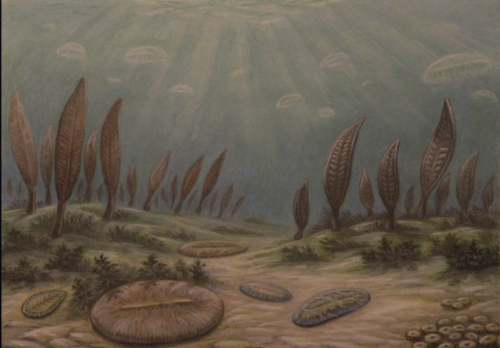Image Courtesy of Wikimedia Commons.
Before the great explosion of biodiversity in the Cambrian period brought nearly all familiar phyla of animals into the world, the seas were home to a completely enigmatic group. Known only from impressions made in stone first found in South Australia, the organisms of the Ediacaran biota—the earliest-known communities of multicellular, macroscopic life—thrived on microbe-carpeted seafloors for nearly one hundred million years. Some were frond-shaped, standing tall like a plant and held to the seafloor by a steadfast; others encrusted themselves into the microbial mat with strange, triangularly symmetric bodies. Not much is known about these creatures, including why their fossils are so abundant.
Upon death, the vast majority of organisms do not enter the fossil record. Instead, most decay, without leaving a geological trace. Soft tissues like organs are especially prone to rapid decomposition. Because the organisms of the Ediacaran biota were soft-bodied, the abundance and quality of their impression fossils have perplexed paleontologists for decades. Most hypotheses for Ediacaran preservation involve rapid cementation of surrounding sediment before the organism decayed, though the chemical reactions mediating cementation were disagreed upon. Early hypotheses suggested iron minerals or clays, but their absence in many Ediacaran fossils has cast doubt on their importance. A recent paper by scientists from Yale, the University of Wisconsin, and the University of California, Riverside, revealed that the secret behind Ediacaran fossil formation lies in silica cement.
“Another hypothesis is that early silica cementation was responsible for molding these organisms. Why? Because you see silica cement ubiquitously in all Ediacaran localities,” said lead author Silvina Slagter, a doctoral student in the Earth and Planetary Sciences Department at Yale. This hypothesis has since gained support, though details behind the processes driving silica cementation have remained fuzzy. “People have thought that quartz [silica] cements formed due to dissolution and reprecipitation of quartz grains, but in this case, […] there are certain textures that you would expect on the borders of grains that we don’t observe,” Slagter said.
Distinct periods of silica cementation at different temperatures are distinguishable by unique oxygen isotope signatures, allowing the team to determine the exact temperature regime the silica cement was deposited in. “We see a trend of oxygen isotope values […] from higher values to lower values farther away from grains associated with the fossils,” Slagter said. This indicates that the first cements formed quickly from dissolved silica in the seawater, creating a mold of the organism before it decayed away. After burial, subsequent cements formed at higher temperatures and filled remaining pore spaces between grains, ensuring long-term preservation of the mold.
These results offer key insight into the mechanisms governing Ediacaran-style preservation. “It’s important to understand how they were preserved to understand what they were and how they [contribute to] a model for the Tree of Life,” Slagter said. While the nature of Ediacaran organisms still eludes paleontologists, a better understanding of their preservation brings us one step closer to uncovering their mystery.

